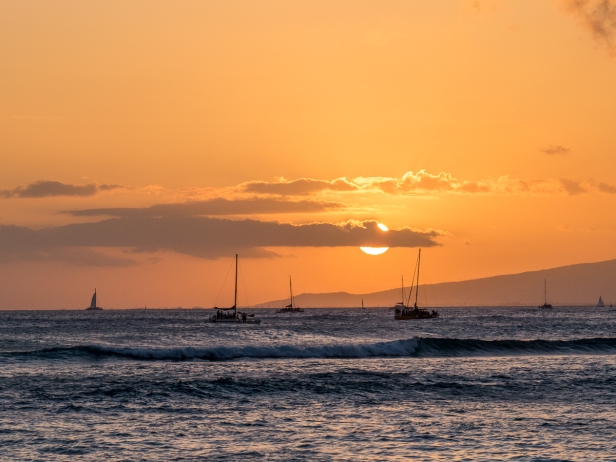
3-6 May 2015. When we flew from Vancouver to Australia in December 2014 we stopped in Hawaii for five days, Samoa for six days, and Fiji for two days. It’s a very sweet way to cross the Pacific – no jet lag and three mini tropical vacations along the way. Returning, nearly six months later, we stopped in Fiji and Hawaii.
We didn’t walk the Diamond Head Summit Trail on Oahu on the way to Australia but promised ourselves we’d do it on the way back.
The trail starts from the middle of a volcanic crater that is more than one kilometre (3500 feet) in diameter. It was formed about 300,000 years ago when the volcano blew its lid off in a single gigantic spectacular explosion. A cloud of particles and ash arose in the air, settled and solidified, forming a rock called tuff. The rim of the crater is tuff and is higher on one side than the other because that’s the way the wind blows.
About two hundred years ago some British sailors saw shiny calcite crystals glittering in the sun and optimistically thought they could be diamonds, hence the name even though no diamonds have ever been found there. The Hawaiian name is Lē’ahi meaning ‘brow of the tuna’. So next time you’re ordering fancy and expensive ahi tuna in a fancy and expensive restaurant you’ll know that you’re ordering tuna tuna, with the first word being Hawaiian. The tuna may or may not have come from Hawaii.
The trail is a two and a half kilometre (one and a half mile) hike from the visitors centre to the top of the crater rim and back. It was built in 1908 as part of the Oahu coastal defense system. It’s easy enough if you don’t mind walking up a bunch of switchbacks,
and two staircases, the first seventy-four steps, and the second ninety-nine steps,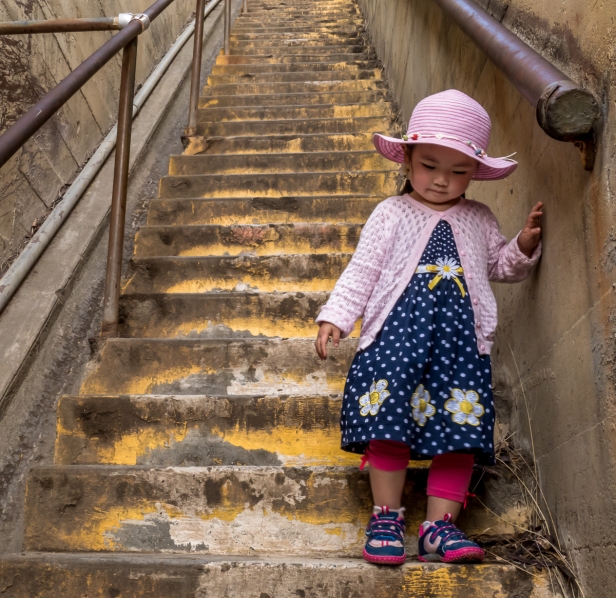
through a dark tunnel,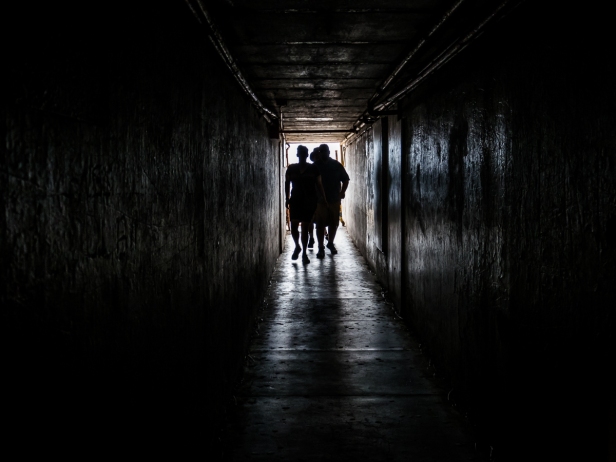
and then through another tunnel, followed by a three-story spiral staircase.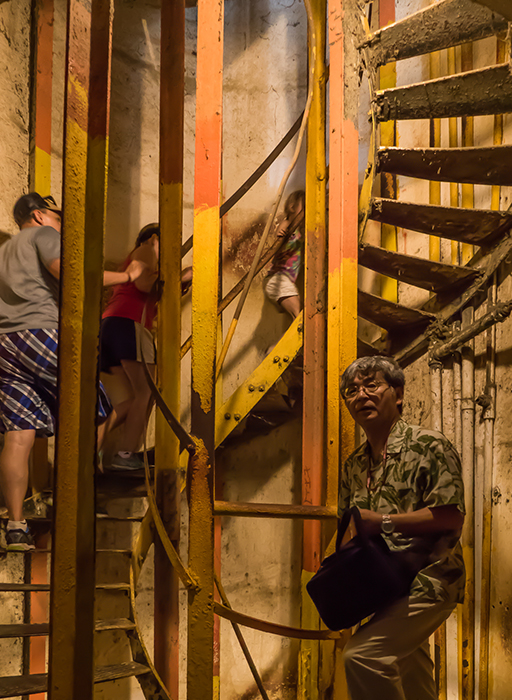
After another fifty-four steps you arrive at the Diamond Head Observation Station. You’ve arrived at the top and the views are magnificent.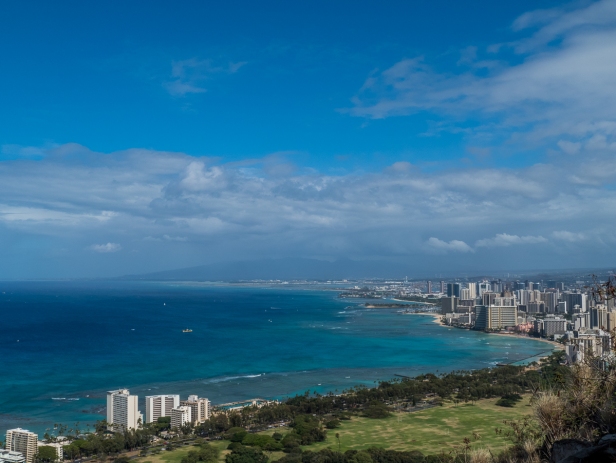
Getting back down is quick and easy if you don’t mind downhill. I prefer uphill. It’s easier on the knees.

On the west coast of Oahu, about forty kilometres (twenty-five miles) west of Honolulu is Ko Olina Resort. We’d been told that it is sometimes possible to see turtles at Ulua Lagoon, the southernmost and least-used of four man-made lagoons at the resort. We head out there with our snorkelling gear all excited and hopeful. Alas the water is way too cold for us to want to swim so we hang out at the beach, photographing the locals,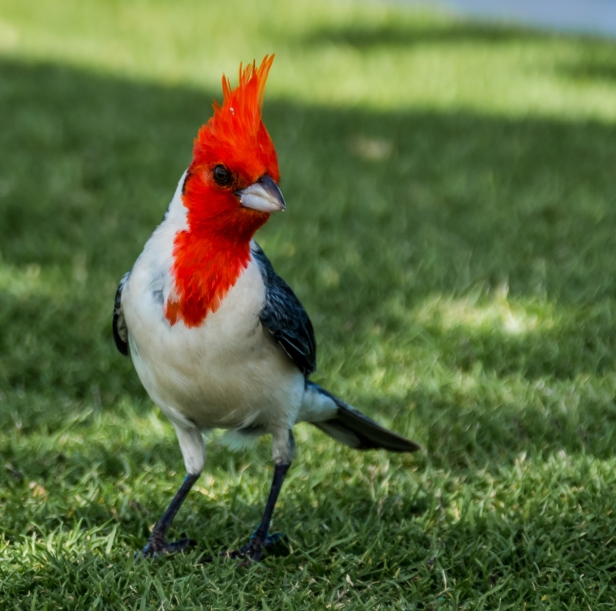
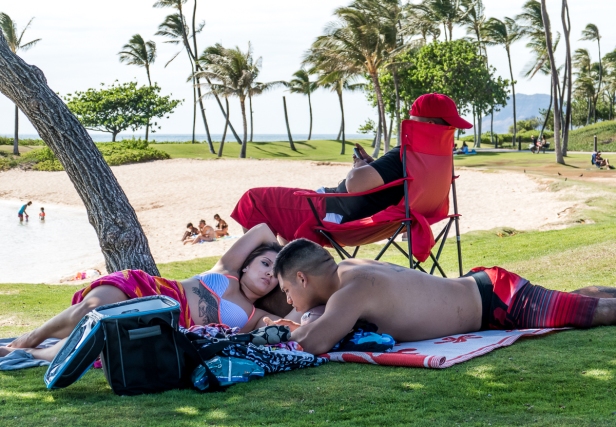
and enjoying the scenery.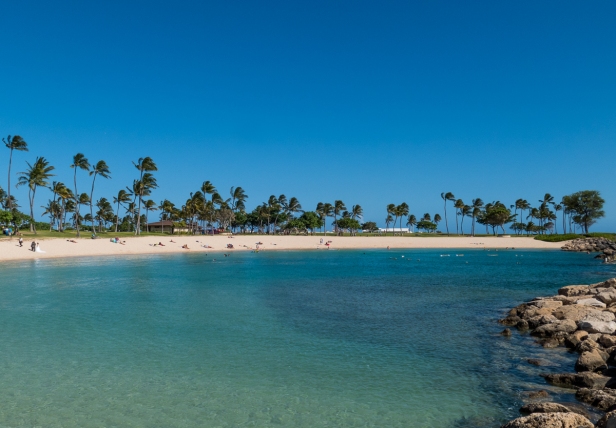
It’s all man-made, and pristine perfect, and very beautiful. Walking through the resort along the beach front, past the lagoons to the north, past the hotels and condos and restaurants, we feel a bit like interlopers. It’s another world.
Back in Honolulu we wander down to Waikiki to watch the surfers and the sunset.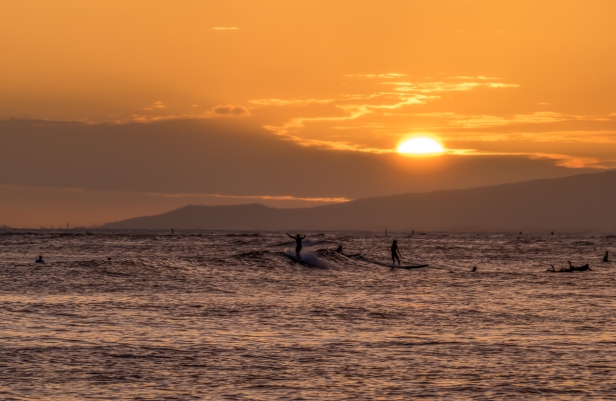
PLEASE DO NOT HANDLE THE PLANTS. NEVER PUT ANY PLANT OR PLANT PART IN YOUR MOUTH. SOME PLANTS ARE POISONOUS AND/OR MAY CAUSE ADVERSE REACTIONS.
Thus admonishes the brochure for Koko Crater Botanical Garden. The garden is about twenty-four kilometres (fifteen miles) east of Honolulu, and I suspect visited by very few tourists to Oahu. Who wants to look at weird plants when there are all those beautiful beaches? And sun tanning. And shopping. And generally lazing around in the tropical pineapple sun-warmed wonderfulness of it all. Well we do. I guess we’re not really beach people all that much unless the water is really really warm, and it isn’t.
Speaking of pineapples, we make a special trip to the Dole Plantation north of Honolulu so I can have a second large serving of their pineapple ice-cream. I had the first on our way to Australia. The whole time we’re there I’m thinking that when we’re back in Hawaii I’m going to have another serve of that ice-cream. Best. Pineapple. Ice-cream. Anywhere. Ever! Best ice-cream anywhere ever. Don thinks its okay. I think it’s a bowl of sheer smooth delicious mouth-watering drooling heaven.
Meanwhile back at Koko Crater Botanical Garden I definitely do not think of eating the plumeria.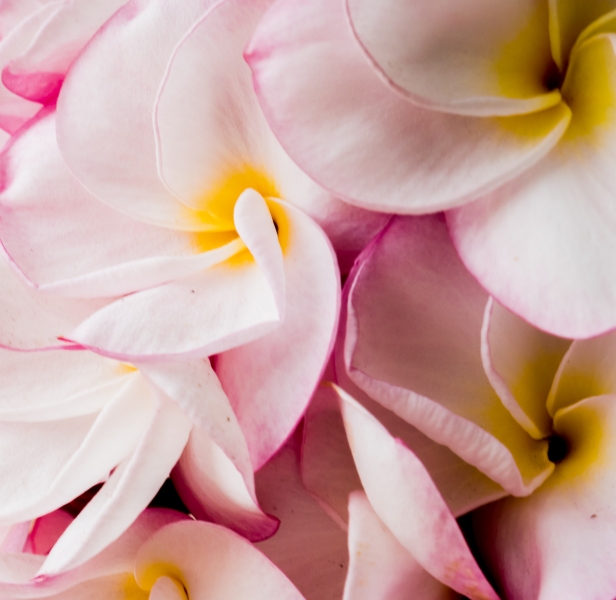
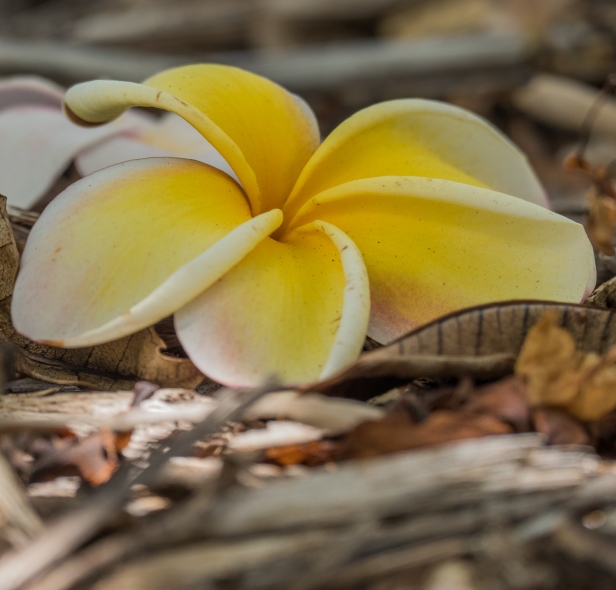
It being a botanical garden, all the plants are labeled. The name plumeria puzzles me. I know the flower, it seems very familiar, as if I should know the name of it, but I’ve never heard of plumeria. Later I discover it is, of course, also known as frangipani, a name that comes from a sixteenth century Italian noble family of the same name. The Marquess invented a plumeria-scented perfume, and thus the family name was passed down through the ages.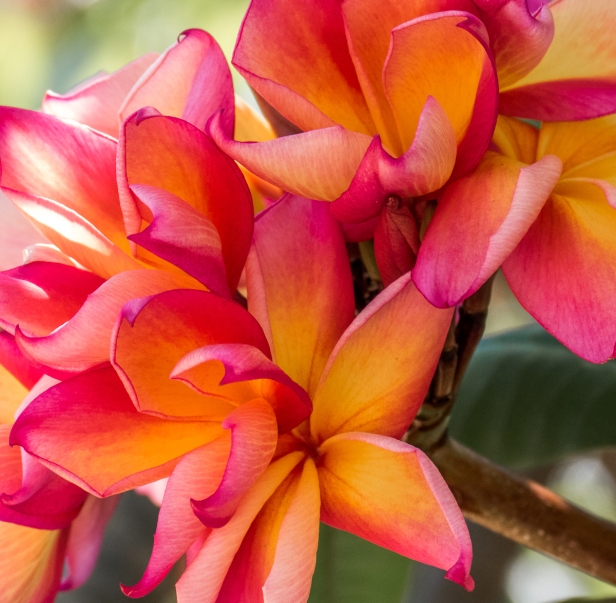
Walking through the garden we discover many weird plants, really weird plants with exotic names. There are pachypodiums from Madagascar, which surely must be lecterns for elephants. And Hawaiian wiliwilis. Are they dust devils in disguise? If so they didn’t move fast enough to get away from an invasion of gall wasps which apparently have had the gall to cover them in galls within which their babies incubate.
There are weird flowers,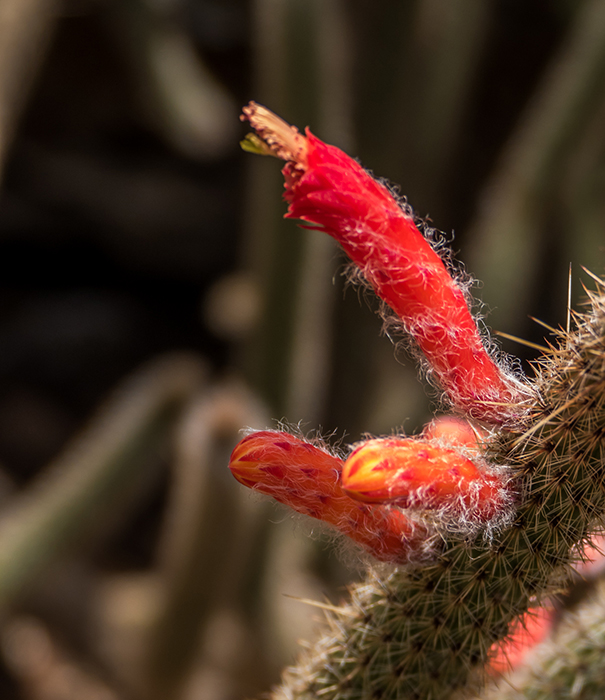
and weird seedpods, all of which are definitely unfamiliar. There are massive round cacti sitting on the ground like giant spiky bowling balls,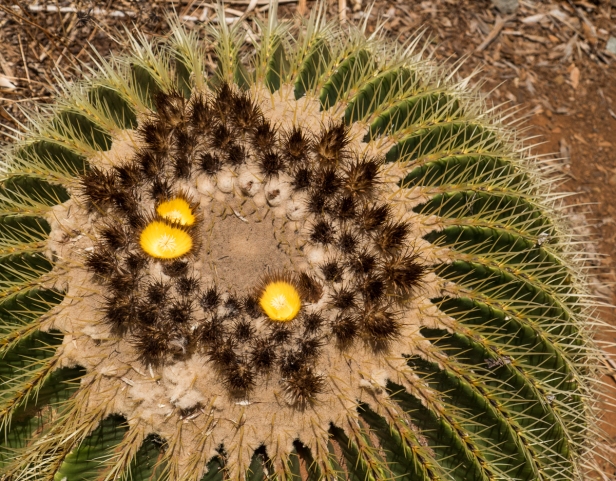
spidery furry flowers,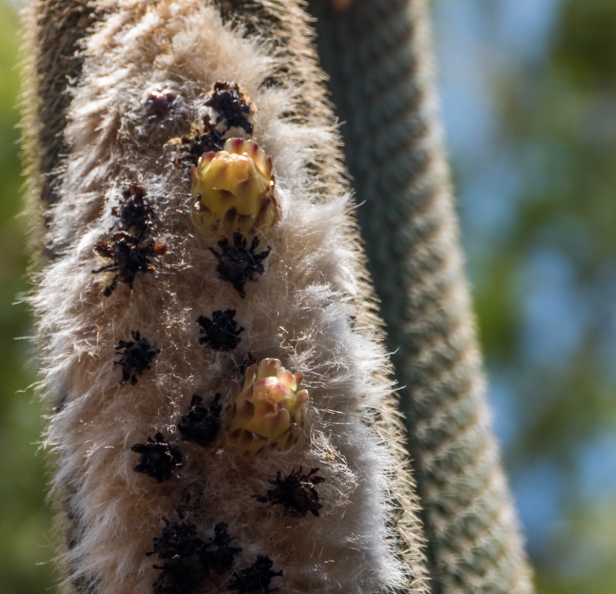
a snarling tangle of green tree snakes,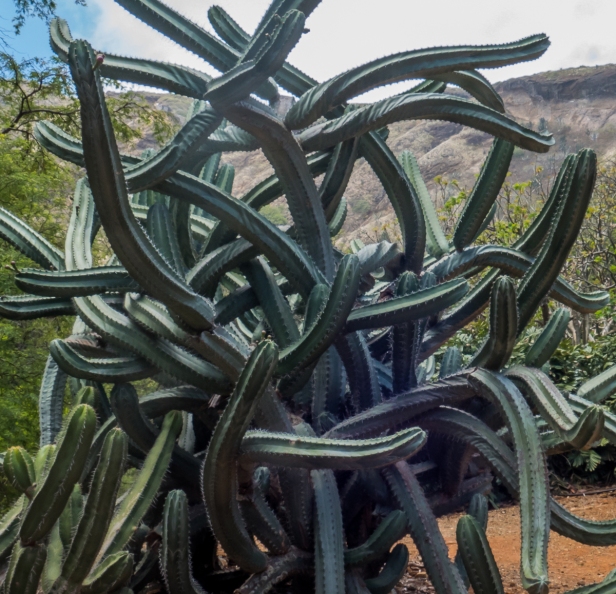
suspended sausages,
and dragon’s blood trees with spiky hair. Eat your heart out Sid Vicious.
Don’t even think about getting close to me, or I will prick you with a thousand needles until you bleed like the sun,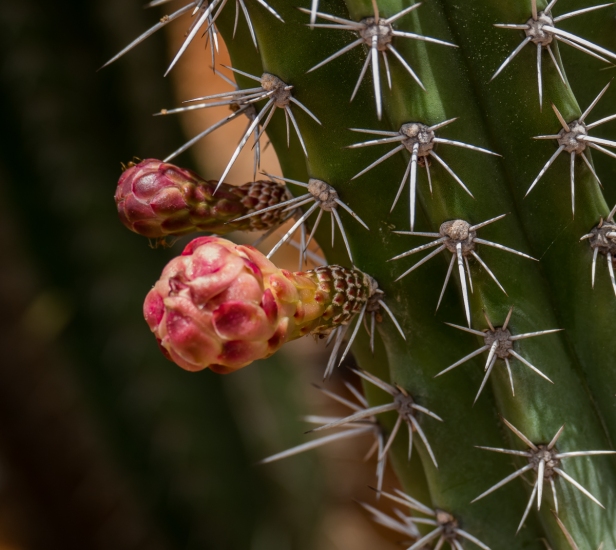
and if you come too near to me a hundred sharp tentacles of doom will reach out, wrap themselves around you, and squish you like a bug. I’m just dozing.
It was a fun garden to visit. We were quite awed by the variety of spectacular and unusual plants. This is a but small selection.
Driving around the island we stop at an obvious lookout point for some views of the rugged coastline, relentless pounding waves, and fishermen living on the edge. One rogue wave could sweep them all away.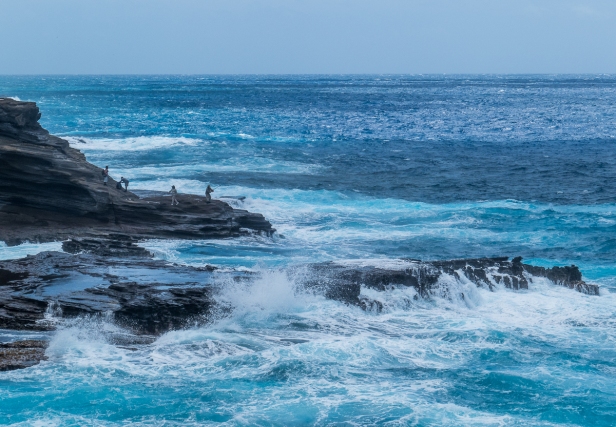
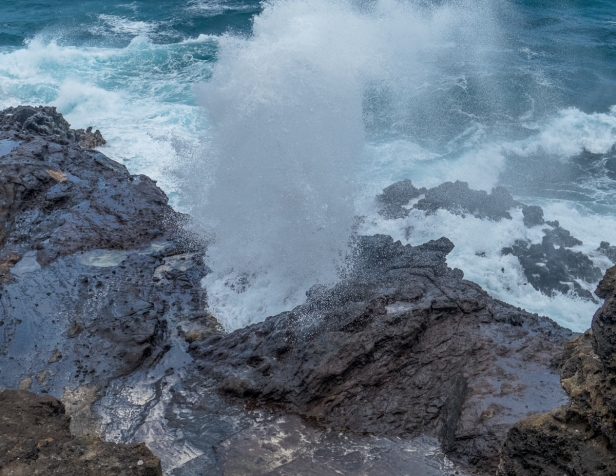
Surrounded by a vast restless ocean, the Hawaiian archipelago is a group of tiny islands, the result of volcanic activity millions of years old. The earth’s plate is still moving, the volcanoes are still spewing lava, the sea roils on, and in the midst of that fishermen fish, a cattle egret forages for food,
a man rests comfortably reading in a tree,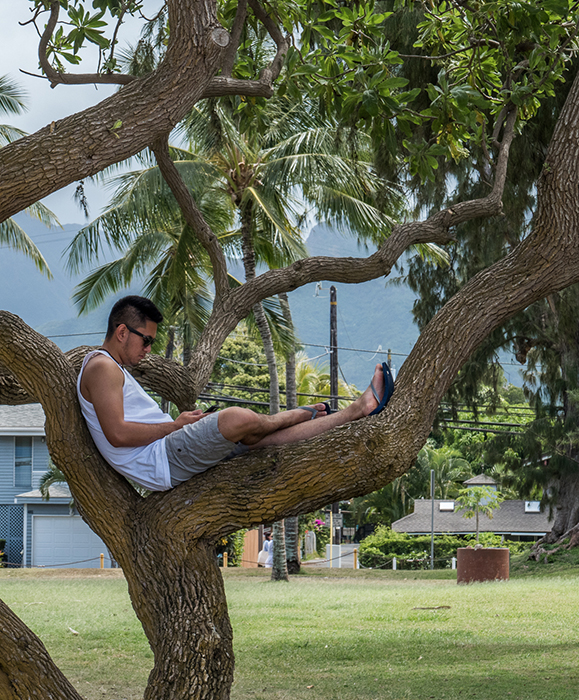
and another man, on Kailua Beach, introduces a young boy to the joy of pigeons.
Most evenings we find ourselves down at Waikiki Beach to watch the surfers, the boogie boarders,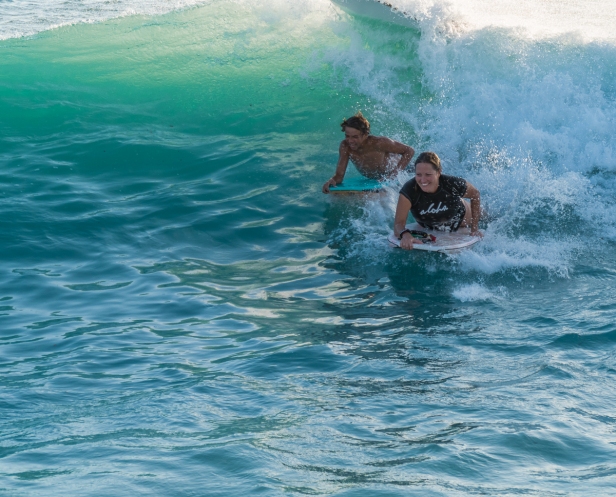
and the sunset.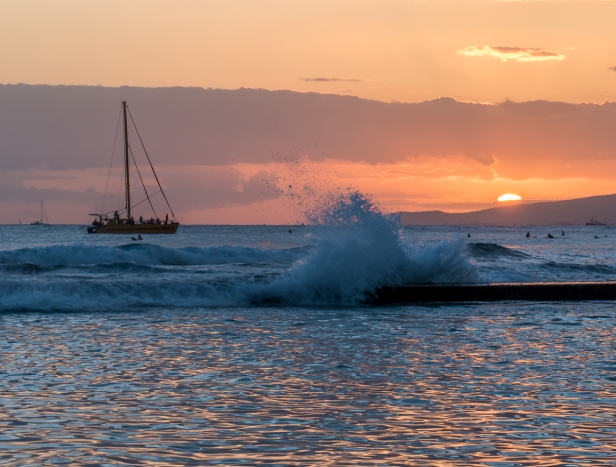
From the pier I watch this little girl,
and her friend. I watch them for hours, or so it feels. I am captivated by their complete ease and joy with their environment. They can’t be more than nine or ten years old, maybe only eight, and yet it appears as if they were born in the water, born to ride the waves. Over and over they paddle out, catch a wave with their boards and ride it in squealing with delight, playing with each other, having fun making whale noises, frolicking in the water like a couple of young dolphins. They are not human at all it seems, but sea creatures, at home and full of joy in the place they love best.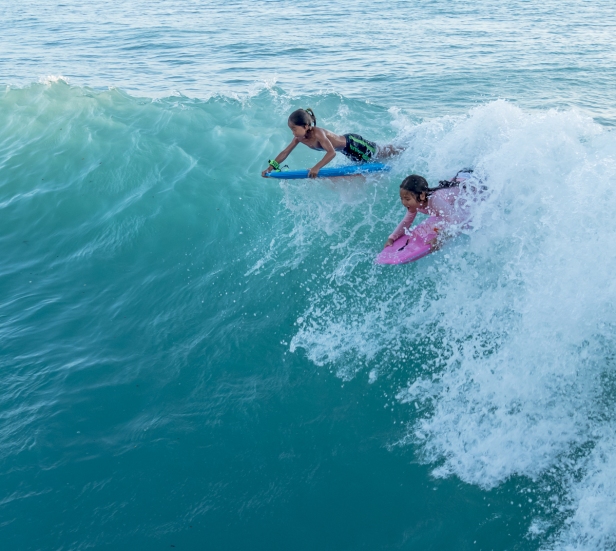
And so ended our time in Hawaii, on the island of Oahu. It was another mini tropical vacation as we headed across the Pacific back to Vancouver. We stayed in Vancouver for two and a half months before travelling to Sweden.
Next travel post: Two weeks in Sweden.
Other posts about Hawaii:
Good-Food-Bad-Food, and Endless Beaches. Aloha From Hawaii
Wildlife Times in Hawaii
All words and images by Alison Louise Armstrong unless otherwise noted
© Alison Louise Armstrong and Adventures in Wonderland – a pilgrimage of the heart, 2010-2015.

wow…beautiful series…love the blue colours and warm feelings.
LikeLiked by 1 person
Thanks so much Hedy. The whole place was blue colours and warm feelings 🙂
Alison
LikeLiked by 1 person
This was fun to read. The pictures are magnificent!!!
LikeLiked by 1 person
Thank you so much Mary. There was so much to photograph in Hawaii, so much beauty, and quirky people and quirky plants. Fun!
Alison
LikeLike
Oh thank you for this beautiful post of a place so close to my heart! We actually went to those botanical gardens, wonderful place!
Hawaii, Samoa, Fiji….wow! How fantastic is that?
LikeLiked by 1 person
You’re welcome Angeline. I’m glad you enjoyed it. I agree Koko Crater Botanical Garden is wonderful – we couldn’t believe some of the plants there! Crossing the Pacific in stages was fabulous. I don’t think we’ll do it any other way now.
Alison
LikeLiked by 1 person
Oh it sounds divine, especially after three flights in a row from Budapest to California. Glorious as usual Alison!
LikeLiked by 1 person
Thanks Cindy. It was definitely absolutely divine! The best way to cross the Pacific. I know what you mean about the three flights in a row from Budapest to California. We just did a 3.30am flight from Cairo to Amsterdam then a 4 hour wait then a 10 hour to Vancouver – brutal!
Alison
LikeLike
These are beautiful photos Alison. Not sure which one I like the best but the little girl walking down the stairs is really special. Hawaii is pretty amazing. What a fun trip you had! Can’t wait to hear about Sweden too. I’ve always wanted to go because my great great grandfather came from Sweden and my maiden name is Anderson. I just haven’t made it yet.
LikeLiked by 1 person
Thank you Nicole. I also like the one of the little girl. She was so sweet. But I especially enjoyed the two young girls boogie-boarding. They were having so much spontaneous uninhibited fun! Their joy was palpable.
It was a fun trip, I can’t imagine crossing the Pacific any other way now.
We don’t travel around Sweden all that much. Don’s son and his wife and family live there so it’s always a family visit at their summer cottage in the country. But we did go to Stockholm for a day. You’ll get to see a bit of the Swedish countryside as well as some of the city. It’s a beautiful country.
Alison
LikeLike
Thanks Alison! Yes trying to fly all the way to Australia without stopping is very long! I will never forget my flight there in the very back of Quantas. It was awful! Breaking it up sounds really nice. Looking forward to your Sweden posts!
LikeLiked by 1 person
I also recently learned that nag champa incense is made from frangipani (and sandalwood).
LikeLiked by 1 person
Ha, I didn’t know that. I would imagine frangipani is used for many things, the scent is so beautiful. I was so confused by the plumeria label. I knew those flowers, and I knew that I also knew the name of them, I just couldn’t remember it in the moment, and I knew it wasn’t plumeria which I’d never heard of. Confusing until I figured it out.
Alison
LikeLike
Absolutely wonderful. .what great clicks..😍
LikeLiked by 1 person
Thank you so much Neethu. I’m glad you enjoyed it.
Alison
LikeLiked by 1 person
It seems the name is not important whether you call the flowers frangipani or plumeria or the volcano Diamond Head or “brow of the tuna” although we’d have to agree that one sounds better than the other! The waves, the birds, the sunsets … there really are places that bring paradise to mind and Hawaii is one of them! Anita
LikeLiked by 1 person
Oh yes, frangipani and Diamond Head are much more attractive names. Hawaii is paradise, and we weren’t even on any of the best islands. I’ve heard that most of the other islands are even more beautiful and unspoilt than Oahu.
Alison
LikeLike
Your trips continue to be amazing.
LikeLiked by 1 person
Thanks so much. The world is amazing that’s for sure. We just *might* show up in Taiwan next summer – and do a little hiking. We know who to ask for advice 🙂
Alison
LikeLike
Well that was a beautiful gallery of photos – and you know I love Hawaii – heading back to the BIG ISLAND in Feb for a month and a half, and already hearing the island calling to me…they say that if you cry when you leave you will be back and I always do. I am blessed to have Hawaii for some of my time and that is a big blessing indeed. I do not live as tourist, but as a part-time resident, and that is a remarkable experience.
LikeLiked by 1 person
Thank you so much Jo Ann. I would love to go to the Big Island one day. I’ve heard that much of it is unspoilt, and that people are aware of how blessed they are to live there. Lucky you. Have a wonderful time! I have friends who went there this time last year for three weeks and they would love to go back so much. They didn’t understand the beauty and allure of the tropics. Now that they do they want more!
Alison
LikeLike
i’m grateful to have shared in your
dreamy, tropical holiday
with such variations
of beauty 🙂
LikeLiked by 1 person
Thank you for coming
along on our tropical journey.
Sweet pineapple vacation 🙂
Alison
LikeLike
What a lovely little interlude. I have never been to Hawaii and so look forward to going one day; I keep putting it off for weirder destinations! I adored those little girls! I am a water bug myself and am going to take a surfing lesson in January in Nicaragua! I am quite sure I will not look quite so relaxed and carefree, though, at least at the beginning! On a thoroughly unrelated note, I saw “sausage trees” in Africa; I wonder if they are the same species as the ones you saw (they look the same)?
LikeLiked by 1 person
Thanks Lexklein. We really loved travelling across the Pacific this way. Do go to Hawaii, but go to the Big Island of one of the others rather than Oahu. Oahu is the most commercialized because of Honolulu, a regular American city which could be anywhere.
The trees are very likely the same species – they had plants from many different countries,and dragon’s blood I believe is an African plant, so the sausage tree could be too.
Have fun in Nicaragua!
Alison
LikeLiked by 1 person
Stunning photos, as always Alison. I never tire of sunsets! – Ginette
LikeLiked by 1 person
Thanks so much Ginette. I too never tire of sunsets. Sometimes I worry that I post too many photos of sunsets, but how could there ever be too much of that beauty in the world?!
Alison
LikeLiked by 1 person
Please continue showering us with the beauty of the world:)
LikeLiked by 1 person
A cold and crisp day here in Colorado, pleasantly interrupted by your warm and watery Hawaiian jaunt. Nice.
LikeLiked by 1 person
Thanks Pam, glad to warm things up a little for you. And for me. We’re in cool and very watery Vancouver, and off to cold and crisp Montreal in two days. Brrrrr
January we go to Mexico yay!
Alison
LikeLike
Great photo essay as always Alison. For all of the times I’ve been to Hawaii over the years, I’ve never climbed Diamond Head. So thanks for the tour up it. Usually I head for other islands. But beauty is everywhere. –Curt
LikeLiked by 1 person
Thanks Curt. I’d love to see the other islands, but we stuck to Oahu because we were only passing through for a few days. Maybe one day we’ll go back for a few weeks and explore the other islands. I’ve heard that they’re quite special.
Alison
LikeLiked by 1 person
What brilliant photographs! Sorry we didn’t connect when you were back, maybe on the flip side? What a contrast from Hawaii/Samoa/Fiji/Australia to Sweden! You’ll have to tell us what it felt like to go from one extreme to another. Safe and sparklie travels.
LikeLiked by 1 person
Thanks so much Donnae. I’m sorry we didn’t connect too – we just get so darn busy taking care of business when we’re back in Van for short visits – doctors, dentists, candlestick makers etc. But we will be here for 5 months in the summer so let’s make it happen then! We’re off to Montreal today for 3 weeks for Christmas with family, then a week turnaround and we’re down to Mexico until June. Sounds pretty sparklie to me 🙂
Hope your own holidays and travels are also safe and sparklie.
Alison
LikeLiked by 1 person
You captured the magic, Alison! Now where in the world are you? Safe travels, wherever you go!
LikeLiked by 1 person
Thanks so much Naomi. We are in Vancouver right now, fly to Montreal tomorrow morning for 3 weeks to visit family, then a week back in Vancouver, then 5 months in San Miguel de Allende, Mexico. Time to rest for a bit. We arrived back in Van just over a month ago from 2 months travelling around Turkey, Jordan and Egypt – posts coming soon.
LikeLiked by 1 person
Have a nice visit! Great to be with family for the holidays. Best wishes for a happy holiday season, Alison!
LikeLiked by 1 person
And to you too Naomi!
A.
LikeLiked by 1 person
Hey, I somehow missed this post. I actually opened it, didn’t read it, and then…missed it because it was already opened. I think that’s how it happened. I’ve never been on this trail. I did get to see the bunkers on top of the volcano, I think it was Diamond Head? Can’t remember details. Need my notes!
Absolutely love the photo of the kids bellyboarding, especially the one just taking off on the wave. Actually makes me want to hop on a board and go surfing.
The guy in the tree is a cool shot, but it would not be comfortable for me…too hard. And the guy sitting in the broken chair feeding pigeons on the beach…what’s up with seating in Hawaii?
The close-up of the cactus flower (with spines showing) is delicious!!
LikeLiked by 1 person
I think the only way to get to the bunkers is by this trail, so maybe you were somewhere else, of forgot about the trail to get there.
Those kids belly-boarding were totally captivating. They were co completely unselfconscious, joyous, at home in the water, and skilled with their boards: a total pleasure to watch for a long time.
It’s not a broken chair, it’s a fold up chair that sits flat on the ground. I used to have one. Some of them fold out to be camping mats.
I also like that photo of the cactus flower, but not sure about delicious 🙂
BTW I recently put a photo of a smiling Indian gypsy girl on FB and it got 52 ‘likes’. I followed it with a stern looking Buddhist monk, that I thought was photographically just as good. It got 4 ‘likes’. I guess people like smiley girls 🙂
Alison
LikeLike
No shortage of scenery! 🙂 My knees hurt with just the thought of all those steps, and then I saw that little one, poised for action. She cured me 🙂 Oh, but those sunsets…
LikeLiked by 1 person
When I was choosing photos for this post I had *four* sunset photos in the mix. It was hard to ditch even one the sunsets were all so magnificent. And yes, fabulous scenery everywhere. The climb was easy enough taking it slowly, even with my old knees.
Alison
LikeLiked by 1 person
Mahalo Nui Loa for this post, Alison. Brought back so many memories. I learned to boogie board at the spot you photographed the little girl. It is called Walls. 36 years ago, I was that little girl. 🙂
I also love the view from Diamond Head. Thank you for putting the kahakō on lē‘ahi. You are a diamond.
{{{Hugs}}} kozo
LikeLiked by 1 person
Thanks so much Kozo, and you’re welcome! I’m glad you enjoyed it. What a fabulous place to learn to ride the waves. It’s so beautiful there. I can imagine you as a child being like the girls, a little sea creature at home in the water.
(((((hugs))))) Alison
LikeLike
Your photos capture the essence of life, and the frangipani are just gorgeous — by any name.
LikeLiked by 1 person
Thanks Kelly. There was so much to photograph in Hawaii, even ordinary stuff. It was hard to choose. I started with 70 photos! I love frangipani. Beautiful to look at, and sweet smelling as well.
Alison
LikeLiked by 1 person
The vegetation in Hawaii is astounding! You made great use of your time there. Have a very Merry Christmas and enjoy fabulous travelling in 2016.
LikeLiked by 1 person
Hawaii is so beautiful. We only stayed on Oahu, but travelled around it quite a lot. I’d love to see some of the other islands some day.
Merry Christmas, and happy travels to you too.
Alison
LikeLike
We´ve been to the big Island and loved it. So diverse. Maui was pretty spectacular too. Thanks for the best wishes. 😀
LikeLiked by 1 person
I loved Hawai’i. I’ve been there twice. Those children with waves….jeez.
LikeLiked by 1 person
We loved Hawaii too. Had a wonderful time there. Yeah, those kids totally blew me away. There ease in the water and with the waves was phenomenal.
Alison
LikeLike
That is a cool way to break up a trans-Pacific journey. I really like the photo of the guy in the tree and the people laying in the grass in the park. Nice captures.
LikeLiked by 1 person
Thanks Jeff. The guy in the tree was one of those serendipitous moments. I didn’t want to stare, but did anyway kind of. I couldn’t believe how comfortable he seemed. And the people on the grass were just too cool to resist with their red chair and red clothing against the green grass backdrop. It was almost as if it had been posed for me. I took lots of shots of them.
Don had a burst lumbar disc. By the time we set out for Australia it was healing well but he’d been warned that the continuous vibrations of a long flight could be problematic so we devised this way across the ocean. It worked out really well and I doubt we’ll ever do it any other way now.
Alison
LikeLike
Many years ago I saw flights to Australia with stops at 3-4 islands on the way and thought that would be a cool way to do it. I guess having a bad back turned out good in one way. You are right – the guy in the tree seems impossibly comfortable for that situation.
Are you still in the Middle East? I look forward to hearing about your adventures there.
LikeLiked by 1 person
We’re back in Canada – Montreal for Christmas with family, then in January we’re off to San Miguel de Allende for 5 months. I have one blog post on Sweden coming up in about a week, and then I start on the Turkey/Jordan/Egypt odyssey. I’m looking forward to putting those posts together – soooo much material.
LikeLike
Wonderful pictures – and a great post title, too 🙂 Shared this on Twitter
LikeLiked by 1 person
Thanks so much Lars. And thanks for the twitter share!
Alison
LikeLike